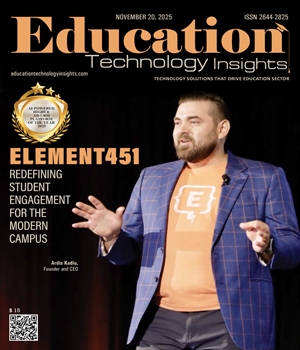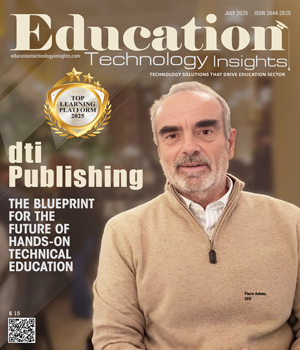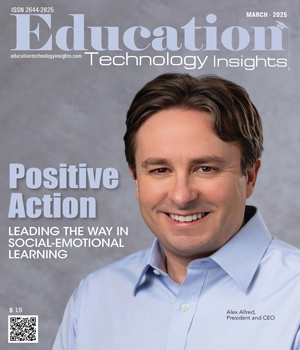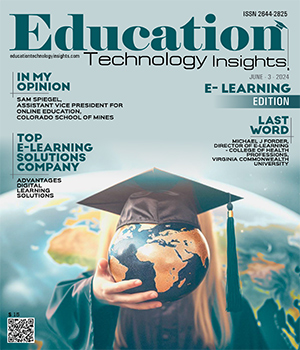THANK YOU FOR SUBSCRIBING
Be first to read the latest tech news, Industry Leader's Insights, and CIO interviews of medium and large enterprises exclusively from Education Technology Insights
Amplifying the Teacher-Learner Relation through E-Learning
Kenny Ward, Director of Specially Designed Instruction, Oklahoma City Public Schools
 Kenny Ward, Director of Specially Designed Instruction, Oklahoma City Public Schools
Kenny Ward, Director of Specially Designed Instruction, Oklahoma City Public SchoolsKenny Ward currently serves as Director of Specially Designed Instruction in a large urban district with approximately 60 schools. His key responsibility is to oversee all the instructional aspects of special education and manage the IEP process. This includes handling challenging outcomes such as complex meetings with parents, advocates or attorneys regarding student issues.
He supervises a team of coordinators and specialists who support implementing special education programs and services across the district. One key member of his team is an assistive technology specialist who ensures that students have access to the necessary assistive technology.
Through this article, Ward delves into the current challenges and trends surrounding e-learning solutions. He shares insights from recent projects and initiatives he’s been involved in, shedding light on innovative approaches to address these challenges.
What are some challenges and trends in e-learning solutions in the marketplace today?
Growing up as a tech enthusiast, I faced the limited availability of computer labs and email facilities to learners, teachers and administrators during the advent of my career, when even drafting individualized education programs (IEPs) was handwritten. Today, technology has become ubiquitous within the education sector, becoming an integral part of every aspect of education endeavors, revolutionizing the teaching and learning process.
While working as a director of online learning, I experienced firsthand the hindrances and opportunities inherent in e-learning, especially during the COVID era. One of the primary hurdles was the initial reluctance among traditional, in-person general education teachers, particularly public school teachers, to fully adopt virtual learning models.
Convincing stakeholders about the effectiveness of online learning, especially for specific segments of the student population, requires diligent effort. Even in the field of special education, there was resistance initially. It was crucial to demonstrate how the virtual e-learning environments can cater to the diverse needs of special education among students.
“No matter what technology you're using or what modality you're operating within, if you don't have the relationship between the teacher and the student, you will struggle to succeed.”
Since the onset of COVID-19, we have developed a highly successful program in just a few years. Our teachers adapted swiftly, reflecting remarkable dedication and skill in adjusting to the new learning environment. This was made possible through purposeful professional development, an understanding of the unique challenges of online learning, and a commitment to responding effectively to data analytics.
We have achieved exceptional results over the three years since the advent of the COVID-19 pandemic.
Another significant aspect is integrating technology effectively into teaching practices. It isn’t merely about providing students with gadgets but enhancing pedagogical approaches. Transitioning to e-learning demanded a shift in teaching methodologies. Educators must adapt to this new paradigm, understanding that replicating traditional classroom methods wasn't always effective in a virtual setting. This necessitated extensive training and support to help teachers navigate the nuances of online instruction.
What recent projects or initiatives have you been involved in regarding online learning?
The most recent major project involved transitioning a district of 35,000 students to online learning. This endeavor required setting up courseware software, deploying Canvas, ensuring access to devices and providing comprehensive training to staff on effective implementation.
Despite the challenges, we achieved significant success. In the first year of implementing the NWEA assessment, our virtual students outperformed their brick-and-mortar counterparts in all areas except kindergarten math. By the second winter assessment, the virtual students consistently outperformed their counterparts in both math and reading across all grade levels, surpassing district averages in student growth. In 60 percent of the areas measured by the NWEA assessment, our students exceed the national growth mean.
What advice would you offer to individuals in a similar position or those aspiring to excel in this field?
The primary element to understand while integrating technology is that we are still working with humans. This can be in terms of students with disabilities, typically developing students, or in virtual or in-person settings; the core of education lies in the humanistic relationship between teacher and student. Despite the types of tools or methods employed or even the integration of technology, the essence of teaching remains rooted in human interaction.
In the virtual program, we experienced the importance of constantly continuing meaningful connections with students and families. The synchronous sessions, along with personal visits to students’ homes, enabled us to emphasize the virtue of nurturing the relationship between the learner and teachers. This dedication to personal connection prevailed even after the post-COVID transition when we went to students’ houses as a team with balloons and music.
Though technology programs, applications, and hardware enhance the pedagogical approach, they fail to substitute genuine human interaction. Technology integrated into a classroom that produces tremendous success with a particular set of learners may give different results with the ways and acts of interaction by another teacher in the same demographic of students.
It signifies that success in education hinges not solely on the tools utilized but on how effectively teachers engage with their students. Each educator interacts through their unique style and approach to integrate the technology that can distinctly influence the outcomes.
Ultimately, while technology can amplify teaching practices, the enduring bond between teacher and student sustains the cornerstone of effective education.
Weekly Brief
Read Also
Goldilocks Regulation
Beyond the Quiz: Redefining Competence in eLearning
Beyond Theory and Into Monday Morning: Enhancing Graduate Programs for Teachers
Safeguarding Students in the Age of Deepfakes: An Educational Imperative
Delivering Excellence in Education through Transformative School Leadership
Curriculum Innovation for Student Success and Institutional Growth

I agree We use cookies on this website to enhance your user experience. By clicking any link on this page you are giving your consent for us to set cookies. More info

























